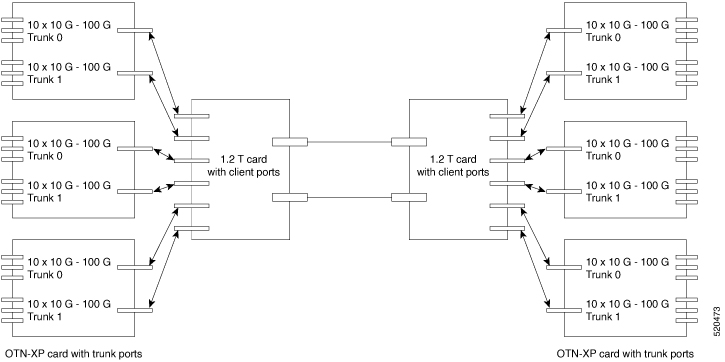The following line cards are supported on Cisco NCS 1004.
NCS1K4-1.2T-K9 C-Band Line Card
The NCS1K4-1.2T-K9 ( or 1.2 Tbps) C-band line card has 12 QSFP-28 based clients and
two DWDM trunk ports. The trunk ports are capable of several line rates with fine
control of modulation format, baud-rate, and forward error correction. The trunk
ports are software configurable. The line card supports module and slice
configurations.

Note
|
"1.2TC" refers to the NCS1K4-1.2T-K9 C-band line card.
|
The features of the 1.2T line card are:
-
The card provides up to 12 100G or OTU4 client ports.
-
The baud rate can be controlled between 28 Gbd/s and 72 Gbd/s.
-
The frequency range is 191.25 to 196.1 THz with a default value of 193.1
THz.
-
The modulation format can be QPSK, 8 QAM, 16 QAM, 32 QAM, or 64 QAM.
-
Hybrid modulations formats can be configured through 1/128 bits/symbol
granularity.
-
Forward Error Correction (FEC) of 27% and 15% overhead across line rates (only 15% for 600G).
-
In Release 7.1.1, the trunk line rate can be configured from 150G to 600G in
50G increments.
-
In Release 7.2.1 and later releases, the trunk line rate can be configured
from 50G to 600G in 50G increments.
NCS1K4-1.2TL-K9 L-Band Line Card
The NCS1K4-1.2TL-K9 (or 800 Gbps) L-band line card has 12 QSFP-28 based clients and
two DWDM trunk ports. The trunk ports are capable of several line rates with fine
control of modulation format, baud-rate, and forward error correction and are
software configurable. The line card supports module and slice configurations.

Note
|
"1.2TL" refers to the NCS1K4-1.2TL-K9 L-band line card.
|

Note
|
There is no support for GMPLS, remote management using GCC, and smart
licensing.
|
The features of the 1.2TL line card are:
-
The card provides up to eight 100G or OTU4 client ports.
-
The client ports map to two trunk ports that operate on any rate between 200G
and 400G with 50G increments.
-
The modulation format can be controlled between QPSK, 8 QAM, and 16 QAM.
-
The baud rate can be controlled between 31.5Gbd/s and 72Gbd/s.
-
The frequency range is 186.10 to 190.85 THz with a default value of 188.50
THz. Only 100 MHz spacing is supported.
-
Hybrid modulations formats can be configured through 1/128 bits/symbol
granularity.
-
Forward Error Correction (FEC) supports 15% and 27% overhead.
NCS1K4-OTN-XP Line Card
From R7.2.1 onwards, NCS 1004 supports the NCS1K4-OTN-XP card with 100G grey-optics
support.

Note
|
"OTN-XP" refers to the NCS1K4-OTN-XP line card.
|
The OTN-XP card contains:
-
Eight QSFP 28 ports
-
Four QSFP-DD ports
-
Two CFP2 ports
The OTN-XP card supports up to 1.6Tbps of OTN aggregation switching functionality to optimize the available bandwidth. A single
line card supports 8x100GE muxponder or 2x400 GE transponder applications. The OTN-XP card supports 400GE/OTUC4, 100GE/OTU4,
10GE/OTU2/OTU2e, 16G FC, and 32G FC client rates.
For more information on the mode configuration, see Muxponder Configuration on OTN-XP Card.
NCS1K4-2-QDD-C-K9 C-Band Line Card
From R7.3.1 onwards, NCS 1004 supports the NCS1K4-2-QDD-C-K9 (or 2-QDD-C) C-Band line
card. The card has eight client ports (QSFP28 and QSFP-DD) and two DWDM dual
sub-channel module trunk ports.The FR4 and AOC are the two optics supported on the
400GE client ports. Each trunk port is capable of 200, 300, and 400 Gbps line rate
with fine control of modulation format, baud-rate, and forward error correction. The
trunk ports are software configurable. The line card supports module and slice
configurations.

Note
|
"2-QDD-C" refers to the NCS1K4-2-QDD-C-K9 C-band line card.
|
The features of the 2-QDD-C line card are:
-
The card provides up to eight 100 GE or two 400 GE client ports.
-
The trunk line rate can be configured from 200G to 400G in 100G
increments.

Note
|
The trunk line rates of 250G and 350G are not supported in R7.3.1.
|
-
The client to trunk port mapping is based on type of configuration and the
line rate.
-
The modulation format can be controlled between QPSK, 8 QAM, and 16 QAM including hybrid modulation.
-
Hybrid modulations formats can be configured through 1/128 bits/symbol
granularity.
-
Forward Error Correction (FEC) of Soft Decision FEC 27% and Soft Decision FEC
15%.
-
The baud rate can be controlled between 28 Gbd/s and 72 Gbd/s.
-
The frequency range is 191.25 to 196.1 THz with a default value of 193.1
THz.
NCS1K4-QXP-K9 3.2T QSFP-DD DCO Transponder Line Card
From R7.7.1 onwards, NCS 1004 supports the NCS1K4-QXP-K9 (or QXP) Line Card. The card has eight client ports (QSFP-DD) and
eight trunk ports (QSFP-DD ZR+).

Note
|
"QXP" refers to the NCS1K4-QXP-K9 C-band line card.
|
The features of the QXP line card are:
-
Each line card supports up to 3.2 Tbps traffic.
-
A single line card supports 6 slices of:
-
4x100GE (breakout) clients in muxponder mode.
-
400GE clients in transponder mode.
-
100GE clients in transponder mode.
-
The client rates that are supported are 400GE, 4x100GE, and 100GE Ethernet only.
-
The modulation formats supported are 16 QAM for 400GE Txp/4x100GE Mxp and QPSK for 100GE Txp.


 Feedback
Feedback